Brake Caliper Replacement Front
Removal Procedure
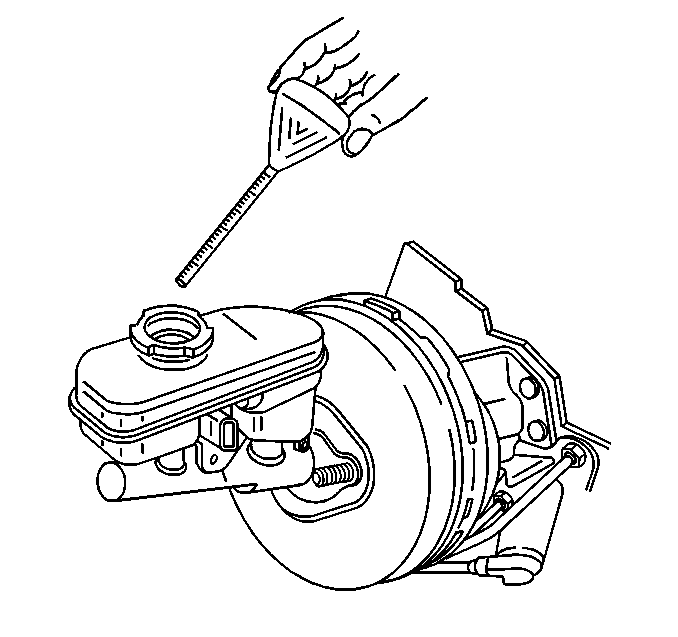
- Remove two-thirds of the
brake fluid from the master cylinder.
- Raise and suitably support the vehicle. Refer to
Lifting and Jacking the Vehicle
in General Information.
- Remove the tire and wheel. Refer to
Tire and Wheel Removal and Installation
in Tires and Wheels.
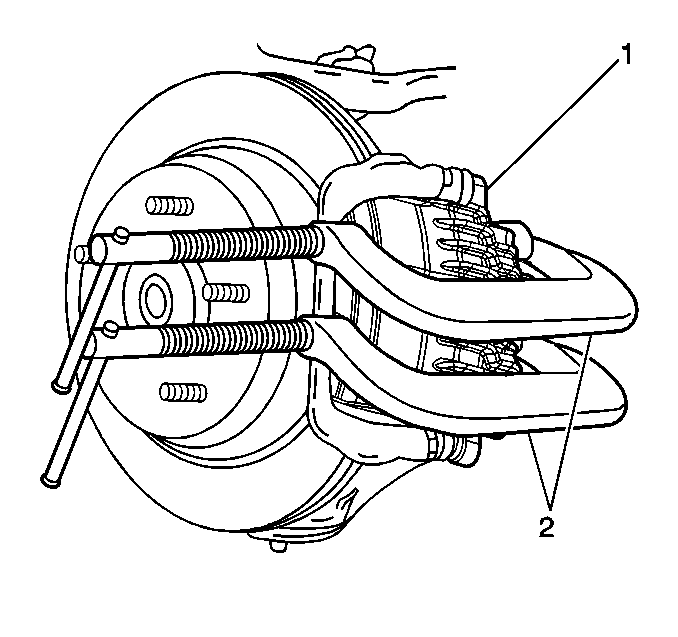
- Push the piston into the
housing bore in order to provide clearance between the pads and the rotor.
| 4.1. | Install a large C-clamp (2) over the top of the caliper
housing (1) and against the back of the outboard pad. |
| 4.2. | Slowly tighten the C-clamp until the piston is pushed into the
caliper bore enough to slide the caliper off the rotor. Do not overtighten
the C-clamp. Overtightening the C-clamp will deform the outboard shoe. |
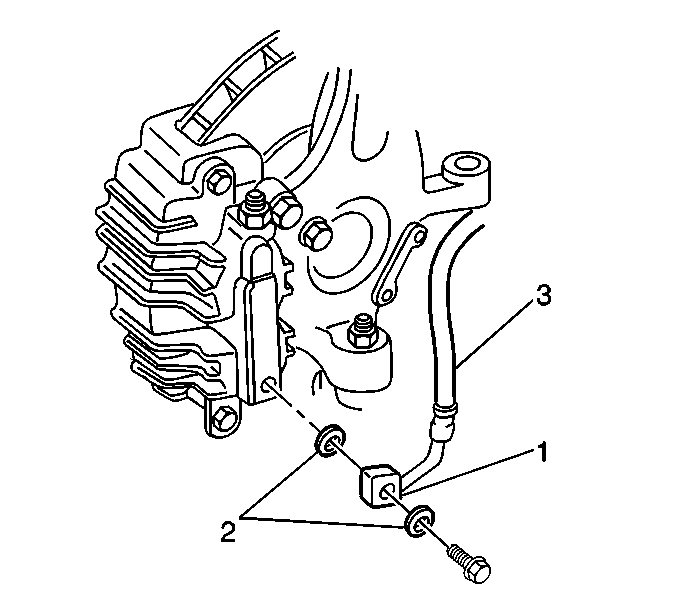
- Complete the following
steps if the caliper is being removed from the vehicle for overhaul or replacement:
| 5.1. | Remove the brake hose bolt attaching the brake hose fitting to
the caliper. |
| 5.2. | Remove the following components: |
| • | The brake hose fitting (1) |
| • | Discard the copper gaskets. |
| • | The brake hose from the caliper (3) |
| 5.3. | Plug the openings in the caliper housing and the hose in order
to prevent loss or contamination of the brake fluid. |
- If the caliper is being removed for service of the mounting plate
or the brake pads, do not disconnect the inlet fitting.

- Remove the brake caliper
guide pin bolts.
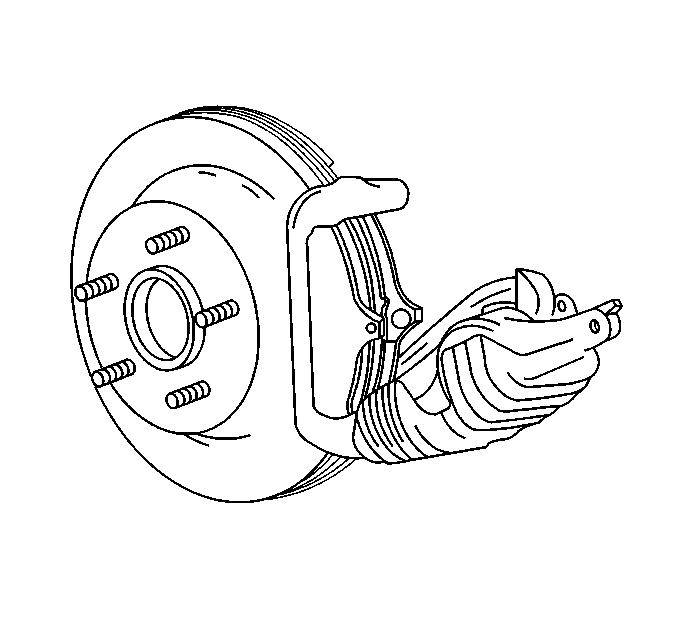
- Remove the caliper housing
from the rotor and the brake caliper mounting bracket.
If the caliper is not being removed from the vehicle, suspend the caliper
from the front suspension using a fabricated wire hook.
- Remove the caliper guide pin bolts and discard.
- Inspect the following parts for corrosion, cuts, nicks or blockage.
Replace any damaged parts.
| • | The caliper guide pin bushings |
| • | If corrosion and/or excessive wear is found, use new parts, including
bushings, when installing the caliper. Do not attempt to polish away corrosion. |
Installation Procedure
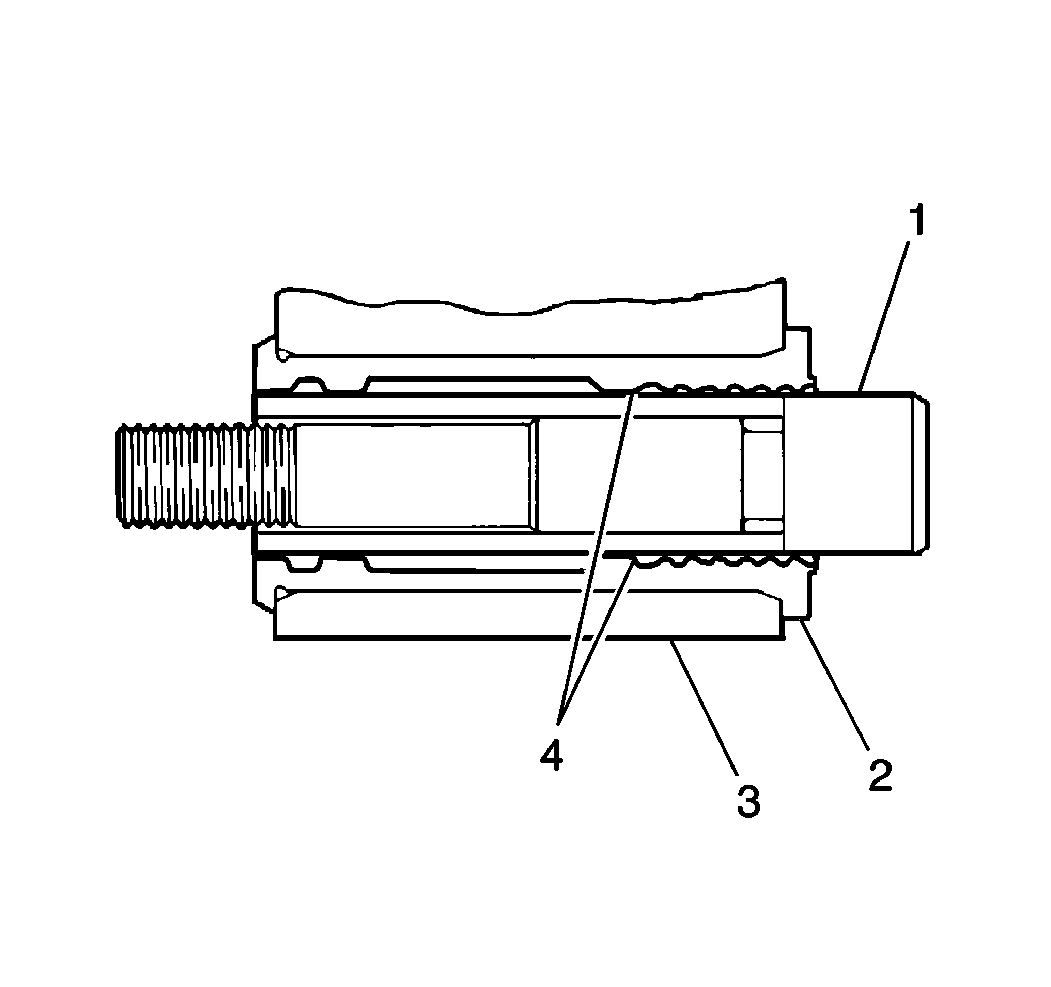
- Lubricate the inner diameters
of the caliper bolt bushings (2) with silicone grease.
- Lubricate the caliper bolts (1). Use silicone grease. Do
not lubricate the threads.
- Inspect the caliper guide pins.
| • | The caliper pin should slide through the pin bushings and caliper
pin bores using only hand pressure. |
| • | If greater force is required, remove the caliper pin and the bushings. |
- Inspect the mounting bores for corrosion.
| • | If corrosion exists, remove the corrosion using a 1-inch wheel
cylinder brush. |
| • | Clean the mounting bores using clean denatured alcohol. |
- Replace the caliper pin and bushings. Refer to
Brake Caliper Overhaul
.

- Install the caliper and
pads onto the mounting bracket.

Notice: Use the correct fastener in the correct location. Replacement fasteners
must be the correct part number for that application. Fasteners requiring
replacement or fasteners requiring the use of thread locking compound or sealant
are identified in the service procedure. Do not use paints, lubricants, or
corrosion inhibitors on fasteners or fastener joint surfaces unless specified.
These coatings affect fastener torque and joint clamping force and may damage
the fastener. Use the correct tightening sequence and specifications when
installing fasteners in order to avoid damage to parts and systems.
- Install the front
brake caliper guide pin bolts.
Tighten
Tighten the front brake caliper guide pin bolts to 31 N·m
(23 lb ft).
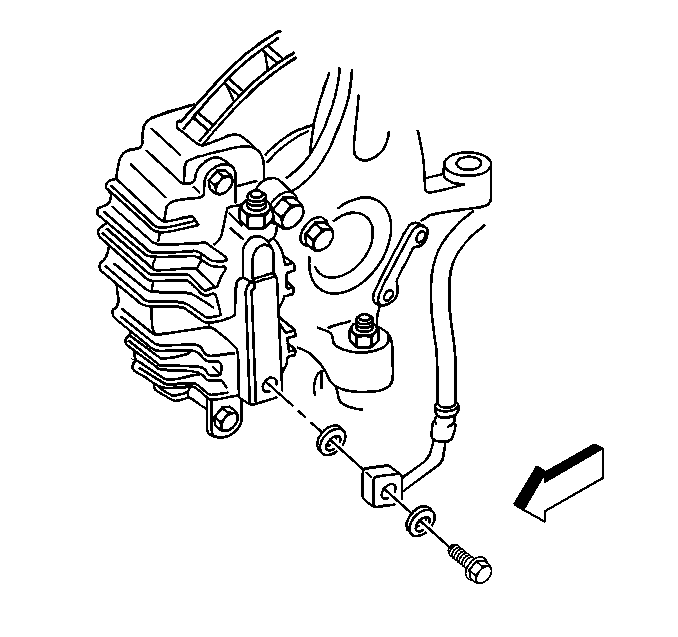
- If the following components
were removed, install them onto the caliper housing using new copper gaskets:
Tighten
Tighten the front brake hose fitting to 40 N·m (30 lb ft).
- Install the tire and the wheel. Refer to
Tire and Wheel Removal and Installation
in Tires and Wheels.
- Lower the vehicle.
Important: If the brake hose was removed, bleed the caliper. Refer to
Hydraulic Brake System Bleeding
in Hydraulic Brakes.
- Fill the master cylinder reservoir to the proper level with clean brake
fluid.
- With engine running, pump brake pedal until firm brake pedal is
attained.
- Check for leaks.
Brake Caliper Replacement Rear
Removal Procedure
- Raise and suitably the vehicle. Refer to
Lifting and Jacking the Vehicle
in General Information.
- Remove the tire and wheel. Refer to
Tire and Wheel Removal and Installation
in Tires and Wheels.
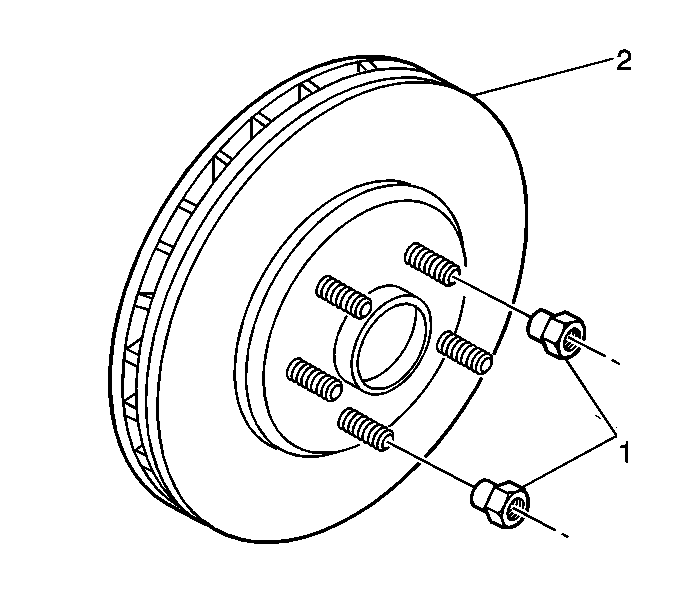
- Reinstall two wheel nuts (1)
in order to secure the rotor (2).
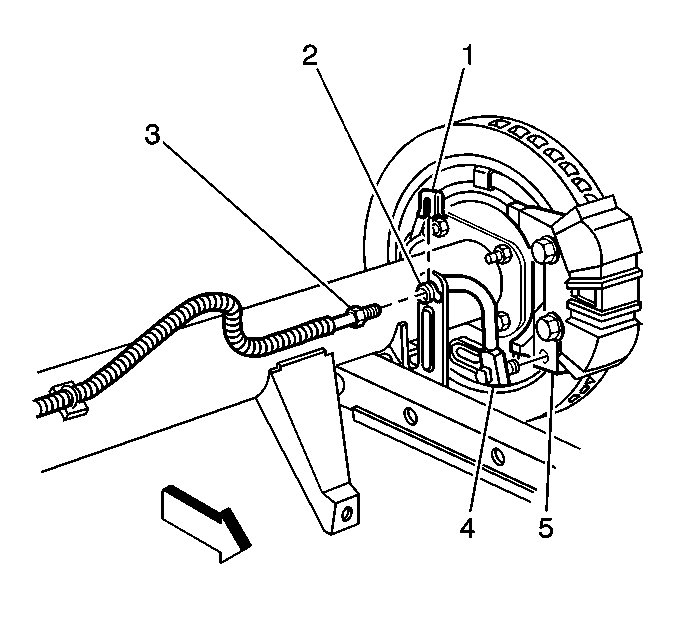
- Complete the following
steps if you are removing the caliper (5) from the vehicle:
| 4.1. | Remove the brake hose bolt attaching the brake hose fitting (4). |
| 4.2. | Remove the following items: |
| • | The brake hose fitting (4) |
| • | Discard the copper gaskets. |
| • | The brake hose from the caliper |
| 4.3. | Plug the openings in the caliper housing and the hose in order
to prevent loss or contamination of the brake fluid. |

- Remove the brake caliper
guide pin bolts and discard.
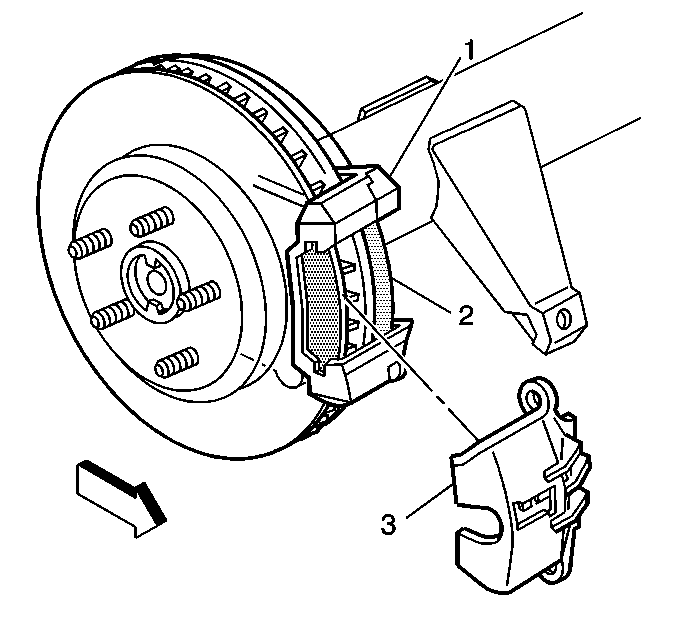
- Remove the rear brake
caliper (3) from the inner and outer pads (2) and mounting
plate (1).
If the caliper is not being removed from the vehicle for unit repair,
suspend the caliper from the rear suspension using a fabricated wire hook.
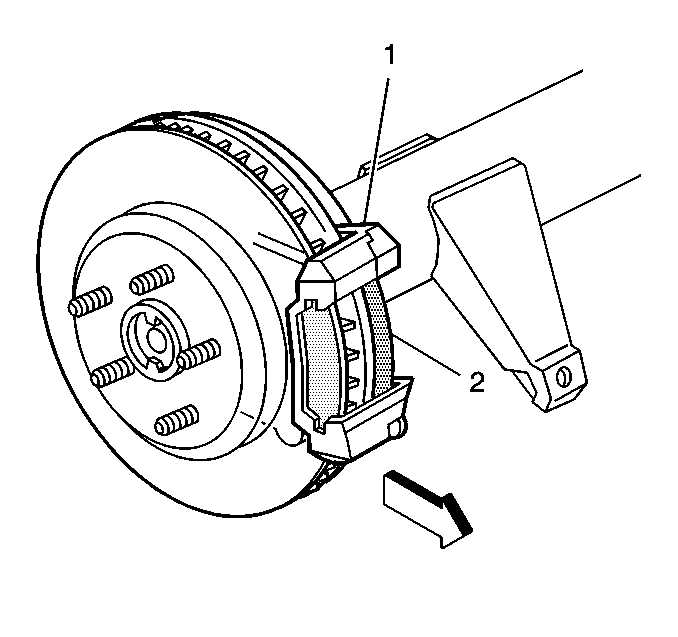
- Remove the inner and outer
brake pads (2) from the mounting plate (1) if the following
conditions exist:
| • | The brake pads are also being replaced. |
| • | The brake caliper mounting plate is also being removed. |
- Inspect the caliper guide pins for free movement in the caliper
mounting plate.
- Inspect the caliper guide pin boot for proper seating in the retaining
groove of the caliper guide pin and the rear caliper mounting plate.
- Replace the guide pins or guide pin boots if the following conditions
exist:
- Lubricate the inner diameters of the caliper bolt bushings with
silicone grease. Also lubricate the caliper bolts with silicone grease.
- Inspect the inner and outer pads for wear.
- Inspect the inner and outer pads for maximum taper.
| • | Maximum taper of the rear brake pads is 0.15 mm (0.006 in). |
| • | If the pads are tapered beyond the maximum specification, replace
the inner and outer pads as a complete set only. |
Installation Procedure

- Install the inner and
outer pads (2) into the mounting plate (1).

- Install the rear brake
caliper (3) over the brake pads (2) and into the caliper mounting
plate (1).
Notice: Use the correct fastener in the correct location. Replacement fasteners
must be the correct part number for that application. Fasteners requiring
replacement or fasteners requiring the use of thread locking compound or sealant
are identified in the service procedure. Do not use paints, lubricants, or
corrosion inhibitors on fasteners or fastener joint surfaces unless specified.
These coatings affect fastener torque and joint clamping force and may damage
the fastener. Use the correct tightening sequence and specifications when
installing fasteners in order to avoid damage to parts and systems.
- Install new brake
caliper guide pin bolts.
Tighten
Tighten the brake caliper guide pin bolts to 37 N·m (72 lb ft).
- Install the following components, if removed:
| • | The new brake hose fitting gaskets |
- Install the brake hose fitting bolt.
Tighten
Tighten the brake hose fitting bolt to 30 N·m (22 lb ft).
- Bleed the brake hydraulic system, if the brake hose fitting was
removed. Refer to
Hydraulic Brake System Bleeding
.

- Remove the wheel nuts
securing the rotor.
- Install the tire and wheel. Refer to
Tire and Wheel Removal and Installation
in Tires and Wheels.
- Lower the vehicle.
- While the engine is running, pump the brake pedal slowly and firmly
three times in order to seat the inner and outer pads.
- Check the brake hydraulic system for leaks.

















